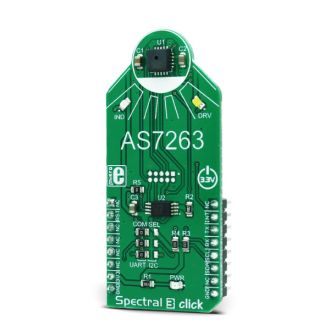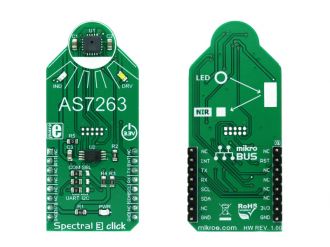
We strongly encourage users to use Package manager for sharing their code on Libstock website, because it boosts your efficiency and leaves the end user with no room for error. [more info]

Rating:
Author: MIKROE
Last Updated: 2018-04-02
Package Version: 1.0.0.0
mikroSDK Library: 1.0.0.0
Category: Optical
Downloaded: 4339 times
Not followed.
License: MIT license
Spectral 3 click is a multispectral sensing device, which uses the state-of-the-art sensor IC for a very accurate near-IR (NIR) sensing. The sensor on the Spectral 3 click provides multi-spectral sensing in the NIR wavelengths from approximately 610nm to 860nm with the full width at half maximum (FWHM) of 20nm.
Do you want to subscribe in order to receive notifications regarding "Spectral 3 click" changes.
Do you want to unsubscribe in order to stop receiving notifications regarding "Spectral 3 click" changes.
Do you want to report abuse regarding "Spectral 3 click".


Library Description
The library carries a generic command parser adopted for AT command based modules. Generic parser.
Key functions:
Examples Description
The demo application is composed of three sections:
void applicationTask()
{
spectral3_process();
spectral3_cmdSingle(&cmdData[0]);
spectral3_getData(&rspBuffer[0],&readData[0]);
IntToStr(readData[0],text);
mikrobus_logWrite( "-- R value:", _LOG_TEXT );
mikrobus_logWrite( text, _LOG_LINE );
IntToStr(readData[1],text);
mikrobus_logWrite( "-- S value:", _LOG_TEXT );
mikrobus_logWrite( text, _LOG_LINE );
IntToStr(readData[2],text);
mikrobus_logWrite( "-- T value:", _LOG_TEXT );
mikrobus_logWrite( text, _LOG_LINE );
IntToStr(readData[3],text);
mikrobus_logWrite( "-- U value:", _LOG_TEXT );
mikrobus_logWrite( text, _LOG_LINE );
IntToStr(readData[4],text);
mikrobus_logWrite( "-- V value:", _LOG_TEXT );
mikrobus_logWrite( text, _LOG_LINE );
IntToStr(readData[5],text);
mikrobus_logWrite( "-- W value:", _LOG_TEXT );
mikrobus_logWrite( text, _LOG_LINE );
mikrobus_logWrite( "---------------------", _LOG_LINE );
Delay_1sec();
}
Along with the demo, application timer initialization functions are provided. Note that timer is configured according to default development system and MCUs, changing the system or MCU may require an update of timer init and timer ISR functions.
mikroE Libraries used in the example:
Additional notes and information
Depending on the development board you are using, you may need USB UART click, USB UART 2 click or RS232 click to connect to your PC, for development systems with no UART to USB interface available on the board. The terminal available in all MikroElektronika compilers, or any other terminal application of your choice, can be used to read the message.